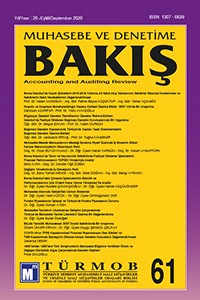Öz
Bu çalışmanın amacı bir finansal manipülasyon yöntemi olan büyük temizlik muhasebesinin, BİST imalat sektöründe işlem gören şirketlerde uygulanıp uygulanmadığını tespit etmektir. Bu amaç doğrultusunda büyük temizlik muhasebesi teorik olarak açıklandıktan sonra, literatürde yer alan mevcut çalışmalar incelenerek çalışmanın hipotezleri ve araştırması tasarlanmıştır. Araştırma kapsamında öncelikle BİST imalat sektöründe 2017 ve 2018 yıllarında işlem gören toplam 178 işletmenin Beneish modeliyle manipülasyon katsayıları hesaplanmıştır. Yapılan analiz sonucunda, CEO veya yönetim kurulu başkanları değişen ve değişmeyen işletmelerin manipülasyon katsayıları arasında istatistiksel olarak anlamlı bir fark bulunmuştur. Bu sonuç örneklemdeki işletmelerin yönetici değişikliği dönemlerinde büyük temizlik muhasebesine başvurdukları yönündeki hipotezi destekler niteliktedir. Araştırma sonuçları büyük temizlik temelli finansal bilgi manipülasyonun varlığını destekler nitelikte olduğundan, ortaklardan devlete tüm bilgi kullanıcıları açısından önem arz etmektedir. Çalışma ayrıca Türkiye’de büyük temizliğin varlığını ortaya koyan ilk çalışmadır.
Anahtar Kelimeler
Büyük Temizlik muhasebe manipilasyonu yönetim değişikliği Beneish modeli
Kaynakça
- Beneish, M. D. (1997). “Detecting GAAP violation: implications for assessing earnings management among firms with extreme financial performance”, Journal of Accounting And Public Policy, 16(3), 271-309.
- Beneish, M. D. (1999). “The detection of earnings manipulation”, Financial Analysts Journal, 55(5), 24-36.
- Beneish, M. D., C. M. Lee, ve D. C. Nichols (2013). “Earnings manipulation and expected returns”, Financial Analysts Journal, 69(2), 57-82.
- Bornemann, S., A. Pfingsten, T.Kick, ve A. Schertler (2014). “Earnings baths by bank CEOs during turnovers”, Bundesbank Discussion Paper No. 05/2014. SSRN: https://ssrn.com/abstract=2796954
- Burg V., J. Pierk ve T. Scheniert (2013), “Big bath accounting and CEO overconfidence”, https://papers.ssrn.com/sol3/papers.cfm?abstract_id=2244870
- De Angelo, L. (1986). “Accounting numbers as market valuation substitutes: a study of management buyouts of public stockholders”, The Accounting Review, 61(3), 400-420.
- Dechow, P. M., R. G. Sloan ve A. P. Sweeney (1995). “Detecting earnings management”, Accounting Review, 70(2), 193-225. Elliott, J. A., ve W. H. Shaw. (1988). “Write-offs as accounting procedures to manage perceptions, Journal of Accounting Research, 26, 91–119.
- Fiechter, P., ve Meyer, C. (2010). “Big bath accounting using fair value measurement discretion during the financial crisis, American Accounting Association Annual Meeting, San Fransisco, https://www.researchgate.net/publication/267402588_Big_Bath_Accounting_using_Fair_Value_Measurement_Discretion_during_the_Financial_Crisis
- Francis, J., J. D. Hanna ve L. Vincent (1996). “Causes and effects of discretionary asset write-offs”, Journal of Accounting Research, 34(3), 117–134.
- Fiechter, P. ve C. Meyer (2009). “Big Bath accounting using fair value measurement discretion during the financial crisis”, Working paper, https://www.researchgate.net/publication/267402588_Big_Bath_Accounting_using_Fair_Value_Measurement_Discretion_during_the_Financial_Crisis
- Itoh, K. (2007). Corporate Valuation, Nihon Keizai Shimbun-sha.
- Jones, M. (2011). Creative Accounting, Fraud and International Accounting Scandals, John Wiley & Sons.
- Haggard, K. S., J. S. Howe, J. S., ve A. A. Lynch (2015). “Do baths muddy the waters or clear the air?”, Journal of Accounting & Economics, 59(1), 105–117.
- Healy, P. M. ve J. M. Wahlen (1999). “A review of the earnings management literature and its implications for standard setting”. Kelley School of Business.
- Hope, O. ve J. Wang (2018). “Management deception, big-bath accounting, and information asymmetry: evidence from linguistic analysis”, Accounting, Organizations and Society, 70, 33- 51.
- Jones J. (1991). “Earnings management during import relief investigation”, Journal of Accounting Research, 29(2), 193 - 228.
- Jordan, C. E. ve S. J. Clark (2004). “Big bath earnings management: the case of goodwill impairment under SFAS No. 142”, Journal of Applied Business Research, 20(2), 63 – 70.
- Küçüksözen C, ve G. Küçükkocaoğlu (2004). “Manipulation Of Financial information: an empirical study on İstanbul Stock Exchange (Ise) Firms”, 1st Annual International Accounting Conference: Istanbul, Turkey; 01/11/2004 - 07/11/2004.
- Küçüksözen, C. (2004). Finansal Bilgi Manipülasyonu: Nedenleri, Yöntemleri, Amaçları, Teknikleri, Sonuçları Ve İMKB Şirketleri Üzerine Ampirik Bir Çalışma, Sermaye Piyasası Kurulu. ISBN 9756951885.
- Moore, M. (1973). “Management changes and discretionary accounting decisions”, Journal of Accounting Research, 11(1), 100-107.
- Mulford, C. W. ve E. E. Comiskey (2002). The Financial Numbers Game: Detecting Creative Accounting Practices, John Wiley & Sons.
- Öcal, N., Y. Atasoy, ve Ö. Öcal (2017). “Muhasebe Bazlı Kazanç Manipülasyonunun Tespitinde Kullanılan Beneish Modelinin Test Edilmesi”, 21. Finans Sempozyumu, Balıkesir.
- Pourciau, S. (1993), “Earnings management and nonroutine executive changes”, Journal of Accounting and Economics, 16 (1- 3), 317-336.
- Riyadi, A., W. Utami ve L. Nugroho. (2018). “Potential big bath accounting practice in CEO changes (study on manufacturing companies listed in Indonesia Stock Exchange)”. International Journal of Accounting and Finance Studies, 1(2), 2018.
- Schaffer U., L. Jan-Philipp, D. Bremer ve H. Matthias H. (2012). “The effect of Accounting Standards on big bath behavior”, Z Betriebswirtsch, 82, 47–73.
- Scott, W. (2009). Financial Accounting Theory, 5th Edition, Prentice Hall.
- Shen, C.-H. ve C- A Wang (2019). “Do new brooms sweep clean? Evidence that new CEOs take a ‘big bath’ in the banking industry”, Journal of Emerging Market Finance, 18(1), 106–144.
- Stolowy, H. ve G. Breton (2004), "Accounts manipulation: a literature review and proposed conceptual framework", Review of Accounting and Finance, 3(1), 5-92.
- Walsh P., Craig, R. ve Clarke, F. (1991), “Big bath accounting using extraordinary items adjustments: Australian empirical evidence”, Journal of Business Finance & Accounting, 18, 173-189.
- Wilson, M. ve L. W. Wang (2010). “Earnings management following chief executive officer changes: the effect of contemporaneous chairperson and chief financial officer appointments”, Accounting & Finance, 50(2), 447–480.
- Yörük, N. ve Doğan, E. (2009). Finansal Bilgi Manipülasyonu ve Finansal Bilgi Manipülasyonunun Belirlenmesine Yönelik İ.M.K.B'da Bir Araştırma, 1.Baskı, Detay Yayıncılık, Ankara.
- Yu, C.-F. (2012). “CEO turnover, earnings management, and big bath”, https://www.semanticscholar.org/paper/CEO-Turnover-%2C-Earnings-Management-%2C-and-Big-Bath-Yu/3060e38fefb7f31498f23e9987aab2d4044fc04d
Ayrıntılar
| Birincil Dil | Türkçe |
|---|---|
| Konular | İşletme |
| Bölüm | Araştırma Makaleleri |
| Yazarlar | |
| Yayımlanma Tarihi | 15 Eylül 2020 |
| Gönderilme Tarihi | 10 Şubat 2020 |
| Kabul Tarihi | 27 Ağustos 2020 |
| Yayımlandığı Sayı | Yıl 2020 Cilt: 20 Sayı: 61 |


